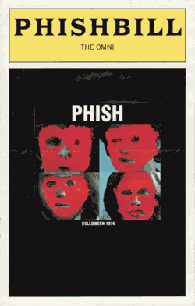
The Phishbill debuted in 1996
1995: Rosemont, IL – the year of the rest of the show
Sure enough, 1995 brought with it another Halloween show and another fan vote. Despite the repeat of the idea, the first set made it abundantly clear that this was not going to be Phish going through the motions, as it was bookended by bizarre stories. The opening “Icculus” was Halloween-themed as the usually omnipotent Helping Friendly Book was having some difficulties. In fact, as Trey memorably screamed, “The book is getting its ass kicked!”
Perhaps it was these evil book destroying spirits that led to the story in the “Harpua.” Instead of the usual cat vs. dog fight, Mike, as is his wont, told a story about a dream. He was in his parents’ house, which was being besieged by raccoons. Mike’s strategy was to push the multitudes of ring tailed mammals into the bedroom but he is ultimately freaked out when he discovers that they’re, “Tiny raccoons! BABY RACOONS!” As befitting a Mike story, this narrative is both surreal and highly quotable.
The band costume this year was Quadrophenia. This cover was the one closest to the studio album. Perhaps that was necessary due to the complex nature of the album with its interlacing themes. That doesn’t mean that there were no interesting details, perhaps the coolest of which is that Phish made a recording of “The Kids Are Alright” to play over the PA at the end of “Helpless Dancer” to match the studio version. In addition to being an impressive feat and providing Phish with “Drowned” to jam on in the future, this set might have had ramifications for The Who. In 1996, The Who reunited to perform Quadrophenia. While they never came out and said that the reunion was in response to Phish’s performance, the timing was awfully coincidental.
How do you top covering an album that many thought could not be performed, not even by the original band? How about with a 40 minute “You Enjoy Myself?” This version is a fan favorite and – like the “Icculus” or the “Harpua” would probably have been a highlight of the tour if it were just played on some random night.
The encore drove home the difference between Phish and The Who. After performing a bluegrass-tinged arrangement of “My Generation,” the band destroyed their instruments in tribute. When Townshend destroyed his guitars, it was a violent act. He would smash it against the microphone stand or the floor of the stage. Phish’s rampage channeled the spirit of suburbia. They were quite meticulous. Fishman used a hammer to do his destruction, making it seem like he was consulting a manual the whole time. The act concluded with a giant cartoony plunger being produced in order to dynamite the drum kit. Same results, but a much different image.
1996: Atlanta, GA – the year of rearrangement
The first two Halloween shows created a pattern. Phish would take a vote from the fans, figure out an album, drop hints that it would be a completely different album, and then switch off at the last second. All of the selections – even the rejected Joe’s Garage – were double albums to help fill out a set. 1996 broke all of the rules. The band chose the album themselves and – rather than play some misdirection game – handed out Phishbills to explain why exactly they chose Remain in Light. At first, people thought it was an elaborate prank. When Trey referenced David Byrne’s “Once in a Lifetime” dance during “Fly Famous Mockingbird,” that seemed akin to the claim to the previous year’s “Harpua,” where Jimmy was allegedly listening to the album that Phish was going to play that year – Thriller.
Sometimes when you’re a prankster, the best trick is to be straightforward. No one will believe you anyway. Sure enough, lights went down for the second set, and they counted down to “Born Under Punches,” much to the surprise of the people who were told multiple times that this was what was going to happen.
Since Remain in Light is a single album, Phish had to rework the album to make it fit a set. Instead of the strict costume that the White Album and Quadrophenia were, this set was a melding. The first 25 minutes of the set (“Born Under Punches,” “Crosseyed and Painless,” “The Great Curve”) are the highlight of the set, and arguably one of the best moments of Phish’s career. The songs are both lengthened and sped up, to the point where the actual Talking Heads album can sound passive once you get used to Phish’s versions.
After “Once in a Lifetime” (which was surprisingly not one of the more popular songs of the set, despite being the only one that most people knew going into it), the album became more mellow to the point where Mike actually sat in an armchair for “Seen and Not Seen.” The set ended on a surreal note with random phrases being repeated through a bullhorn and Colonel Bruce Hampton, Ret.) operating a jackhammer on stage and televisions being tuned to static-filled pictures. Talking Heads’ desire for visual stunts met Phish’s wackiness and that was the result.
The lesson of 1996 was that Phish could range a little further in their choices of covers. They could choose a more obscure band and could use the freedom of obscurity to expand and redefine the songs. Both of those trends would be extended in Las Vegas.


No Comments comments associated with this post